

(PDF) An Attribution Theory of Motivation and Emotion. Motivation. Motivation to Learn: An Overview Citation: Huitt, W. (2011).

Motivation to learn: An overview. Educational Psychology Interactive. Valdosta, GA: Valdosta State University. Retrieved from. Motivation. Introduction to Motivation. What is Intrinsic Motivation? A Typology of Computational Approaches. What Does Intrinsic Motivation Mean? What Is Extrinsic Motivation ? What Is Extrinsic Motivation and Is It Effective? Extrinsic Motivation - Psychestudy. Extrinsic vs intrinsic motivation - The UK's leading Sports Psychology Website · The UK's leading Sports Psychology Website. Extrinsic motivation is ‘external’: people – in this case athletes – are driven to succeed by factors from outside i.e. money, prizes, acclaim, status, praise.

Intrinsic motivation comes from within i.e. an athlete driven by a need to succeed because they want to be the best and are not overly concerned by financial or ego boosts. According to Hardy, Jones and Gould (1993) elite athletes must have high levels of intrinsic motivation in order to sustain effort through dips in form and confidence. A well-known football (soccer) manager (Martin O’Neill) said recently that the best players to work with were the ones that were unconcerned about how much they earn. Rio Ferdinand has recently tweeted that he would still be a footballer even if he was on the average wage. Perhaps the professionalisation of rugby has ruined it.
Extrinsic Rewards and Motivation: Association for Applied Sport Psychology. Intrinsic and Extrinsic Motiv ation Among Adolescent Ten-Pin Bowlers in Kuala Lumpur, Malaysia. The relationships between motivation type and sport participation among students in a South African context. MOTIVATIONAL DETERMINANTS OF RISKTAKING : Atkinson 1957. Achievement Motivation (Atkinson & McClelland – 1953) In contrast with theories of motivation based on biological and behavioral determinants are theories of motivation based on cognitive and social cognitive perspectives.
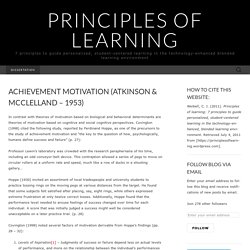
Covington (1998) cited the following study, reported by Ferdinand Hoppe, as one of the precursors to the study of achievement motivation and “the key to the question of how, psychologically, humans define success and failure” (p. 27): Professor Lewin’s laboratory was crowded with the research paraphernalia of his time, including an odd conveyor-belt device. This contraption allowed a series of pegs to move on circular rollers at a uniform rate and speed, much like a row of ducks in a shooting gallery… Hoppe (1930) invited an assortment of local tradespeople and university students to practice tossing rings on the moving pegs at various distances from the target.
He found that some subjects felt satisfied after placing, say, eight rings, while others expressed extreme frustration at only twelve correct tosses. 1. 2. 1. 2. Flow theory – goal orientation theory: positive experience is related to athlete’s goal orientation. Introduction As managing negative emotions has been the primary focus of practitioners in the past, positive emotions have received limited examination in the sporting context.
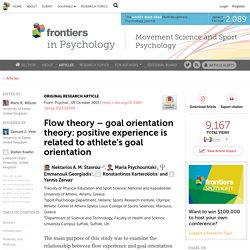
Around the beginning of millennium this trend started to shift as a theoretical approach has emerged, under the name positive psychology (Seligman and Csikszentmihalyi, 2000). This new scientific field focused on the study of positive experience, trying to find the pathways to improve humans functioning, performance, and well-being. However, this approach is not new as three decades earlier Csikszentmihalyi (1982) started building this trend through the flow theory, examining ways to create and control this positive experience. Goal Orientations Theory of Motivation. Goal orientations are cognitive representations of the general type of goal an individual will tend to pursue.
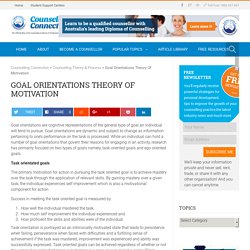
Goal orientations are dynamic and subject to change as information pertaining to one’s performance on the task is processed. While an individual can hold a number of goal orientations that govern their reasons for engaging in an activity, research has primarily focused on two types of goals namely, task oriented goals and ego oriented goals. Task orientated goals The primary motivation for action in pursuing the task oriented goal is to achieve mastery over the task through the application of relevant skills. By gaining mastery over a given task, the individual experiences self improvement which is also a motivational component for action. Success in meeting the task oriented goal is measured by: How well the individual mastered the task,How much self improvement the individual experienced andHow proficient the skills and abilities were of the individual. Student Goal Orientation, Motivation, and Learning.
Applying Goal Orientation Theory in an Exploration of Student Motivations in the Domain of Educational Leadership. Personal Training Attribution Theory. This article discusses why it is so important for a Personal Trainer to find out what a client believes is the cause of their success or failure.
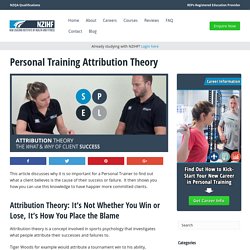
It then shows you how you can use this knowledge to have happier more committed clients. Attribution Theory: It’s Not Whether You Win or Lose, It’s How You Place the Blame Attribution theory is a concept involved in sports psychology that investigates what people attribute their successes and failures to. Tiger Woods for example would attribute a tournament win to his ability, determination and mental toughness. In contrast, a new gym member who has lead a sedentary lifestyle and has low self confidence might see any success they achieve as being lucky. Attribution in sport and exercise psychology: Seeking congruence between theory, research and practice.
Abstract Objectives This paper urges revision of the way attributions are conceptualised, investigated, and applied in sport psychology.
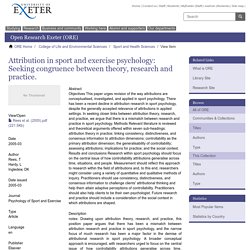
There has been a recent decline in attribution research in sport psychology, despite the generally accepted relevance of attributions in applied settings. In seeking closer links between attribution theory, research, and practice, we argue that there is a mismatch between research and practice in sport psychology. Methods Relevant literature is reviewed and theoretical arguments offered within seven sub-headings: attribution theory in practice; linking consistency, distinctiveness, and consensus information to attribution dimensions; controllability as the primary attribution dimension; the generalisability of controllability; assessing attributions; implications for practice; and the social context.
Description publication-status: Published types: Article Copyright © 2005 Elsevier B.V. Attribution Theory. Senior Fitness You can help your older clients rethink their self-defeating approach to fitness.
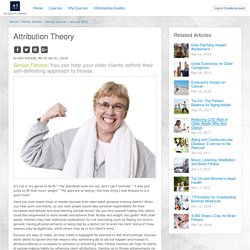
It’s not in my genes to be fit.” “My grandkids wore me out, and I can’t exercise.” “I was just lucky to lift that much weight.” “My days are so boring—the only thing I look forward to is a good meal.” Have you ever heard these or similar excuses from older-adult personal training clients? Excuses are easy to make, as they create a scapegoat for exercise or diet shortcomings. In behavioral psychology, attribution theory suggests that people attribute successes and failures to either internally or externally controlled forces and either stable or unstable traits (intrinsic personality characteristics, behaviors or thought patterns) (Weiner 1985). In older adults, common attributions for a lack of physical activity include age, declining health, prior injuries, doctor’s orders or low levels of energy. To reframe this attribution, Schroeder uses gentle encouragement. Attribution Case Studies with Elite Junior Australian Footballers and Their Coach.
Sport Psychology: the importance of attributions. One of the most thought-provoking and imaginative sport psychology book titles I have seen recently is Susan Halden-Brown’s Mistakes worth making(1). For me, this title captures the essence of positive thinking and optimism, characteristics that can become important companions on the journey towards peak performance. I have always believed that occasional failures are a natural part of the learning process, since I have yet to meet a sports performer who has never experienced setbacks.